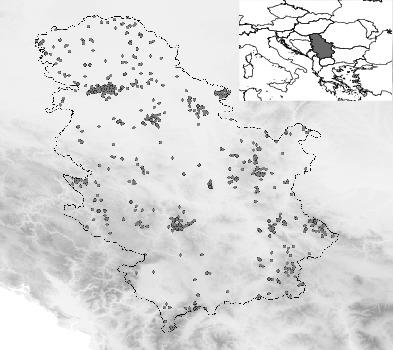当前位置:
X-MOL 学术
›
Entomol. Sci.
›
论文详情
Our official English website, www.x-mol.net, welcomes your feedback! (Note: you will need to create a separate account there.)
Protected areas and prime hoverfly areas: Safe haven for hoverflies or not?
Entomological Science ( IF 0.9 ) Pub Date : 2020-03-24 , DOI: 10.1111/ens.12411 Marina Janković 1 , Marija Miličić 2, 3 , Jelena Ačanski 2 , Ante Vujić 1
Entomological Science ( IF 0.9 ) Pub Date : 2020-03-24 , DOI: 10.1111/ens.12411 Marina Janković 1 , Marija Miličić 2, 3 , Jelena Ačanski 2 , Ante Vujić 1
Affiliation

|
The efficiency of protected areas (PAs) has often been questioned due to global decline of biodiversity. Invertebrates, especially insects, have been historically underrepresented in conservation studies. Our study focuses on hoverflies, an important group of insect pollinators and proven to be good bioindicators. Research was focused in Serbia, one of Europe's hotspots of hoverfly diversity, with a long tradition of hoverfly research, which provided sufficient information for achieving our aims: identifying areas of high hoverfly diversity, evaluating the efficiency of PAs and prime hoverfly areas (PHAs) in the conservation of hoverflies, determining how well they cover the distribution of hoverfly species, especially those of conservation concern, and testing the importance of the size of the area for conservation of hoverfly diversity. We applied weighting of the species to help stress the importance of species of conservation concern. The results indicated that PHAs cover the areas with high hoverfly diversity better than PA networks, especially when it comes to species of conservation concern. Generalized linear model results showed that the area size was a significant predictor of number of species in both PA and PHA. This indicates that area size is key when designating new areas important for conservation, but there are also other factors that need to be taken into account, such as habitat quality or suitability. Studies like this are useful in aiding designation of new areas important for conservation of certain species and in identifying sampling gaps, which could potentially aim future research in that direction.
中文翻译:

保护区和主要食蚜蝇地区:食蚜蝇的避风港?
由于全球生物多样性的下降,保护区 (PA) 的效率经常受到质疑。无脊椎动物,尤其是昆虫,历来在保护研究中的代表性不足。我们的研究侧重于食蚜蝇,这是一组重要的昆虫传粉者,被证明是良好的生物指示剂。研究集中在塞尔维亚,它是欧洲食蚜蝇多样性的热点地区之一,有着悠久的食蚜蝇研究传统,为实现我们的目标提供了足够的信息:确定食蚜蝇高度多样性的区域,评估 PA 的效率和主要食蚜蝇区域 (PHA)在食蚜蝇的保护中,确定它们覆盖食蚜蝇物种分布的程度,尤其是那些保护关注的物种,并测试区域大小对保护食蚜蝇多样性的重要性。我们应用了物种的权重来帮助强调保护关注物种的重要性。结果表明,PHA 比 PA 网络更好地覆盖了食蚜蝇多样性高的区域,尤其是在涉及保护问题的物种方面。广义线性模型结果表明,面积大小是 PA 和 PHA 中物种数量的重要预测因子。这表明,在指定对保护重要的新区域时,面积大小是关键,但还需要考虑其他因素,例如栖息地质量或适宜性。像这样的研究有助于指定对某些物种的保护很重要的新区域,并有助于确定采样差距,这可能使未来的研究朝着这个方向发展。
更新日期:2020-03-24
中文翻译:

保护区和主要食蚜蝇地区:食蚜蝇的避风港?
由于全球生物多样性的下降,保护区 (PA) 的效率经常受到质疑。无脊椎动物,尤其是昆虫,历来在保护研究中的代表性不足。我们的研究侧重于食蚜蝇,这是一组重要的昆虫传粉者,被证明是良好的生物指示剂。研究集中在塞尔维亚,它是欧洲食蚜蝇多样性的热点地区之一,有着悠久的食蚜蝇研究传统,为实现我们的目标提供了足够的信息:确定食蚜蝇高度多样性的区域,评估 PA 的效率和主要食蚜蝇区域 (PHA)在食蚜蝇的保护中,确定它们覆盖食蚜蝇物种分布的程度,尤其是那些保护关注的物种,并测试区域大小对保护食蚜蝇多样性的重要性。我们应用了物种的权重来帮助强调保护关注物种的重要性。结果表明,PHA 比 PA 网络更好地覆盖了食蚜蝇多样性高的区域,尤其是在涉及保护问题的物种方面。广义线性模型结果表明,面积大小是 PA 和 PHA 中物种数量的重要预测因子。这表明,在指定对保护重要的新区域时,面积大小是关键,但还需要考虑其他因素,例如栖息地质量或适宜性。像这样的研究有助于指定对某些物种的保护很重要的新区域,并有助于确定采样差距,这可能使未来的研究朝着这个方向发展。


























 京公网安备 11010802027423号
京公网安备 11010802027423号